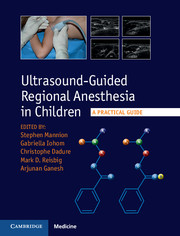Book contents
- Frontmatter
- Contents
- List of contributors
- 1 Introduction
- Section 1 Principles and practice
- Section 2 Upper limb
- 7 Ultrasound-guided axillary brachial plexus block
- 8 Ultrasound-guided supraclavicular brachial plexus block
- 9 Ultrasound-guided infraclavicular brachial plexus block
- 10 Ultrasound-guided interscalene brachial plexus block
- Section 3 Lower limb
- Section 4 Truncal blocks
- Section 5 Neuraxial blocks
- Section 6 Facial blocks
- Appendix: Muscle innervation, origin, insertion, and action
- Index
- References
8 - Ultrasound-guided supraclavicular brachial plexus block
from Section 2 - Upper limb
Published online by Cambridge University Press: 05 September 2015
- Frontmatter
- Contents
- List of contributors
- 1 Introduction
- Section 1 Principles and practice
- Section 2 Upper limb
- 7 Ultrasound-guided axillary brachial plexus block
- 8 Ultrasound-guided supraclavicular brachial plexus block
- 9 Ultrasound-guided infraclavicular brachial plexus block
- 10 Ultrasound-guided interscalene brachial plexus block
- Section 3 Lower limb
- Section 4 Truncal blocks
- Section 5 Neuraxial blocks
- Section 6 Facial blocks
- Appendix: Muscle innervation, origin, insertion, and action
- Index
- References
Summary
Clinical use
Supraclavicular brachial plexus blockade is becoming more widely utilized in both adult and pediatric patients. A single injection with the supraclavicular approach to brachial plexus blockade can provide complete anesthesia and analgesia for surgical procedures on the upper extremity distal to the shoulder. Supplementation of the block to include the suprascapular nerve branch, which exits the upper trunk (C5–C6) prior to its entry into the supraclavicular fossa, facilitates analgesia for shoulder procedures. Successful blockade of the brachial plexus can reduce opioid consumption and opioid-related side effects, while providing excellent post-operative analgesia. In-depth anatomic knowledge of the brachial plexus and surrounding structures is necessary for efficacious blockade and the prevention of complications.
The supraclavicular blockade of the brachial plexus was first described by the German surgeon, Kulenkampff in 1911 (Kulenkampff, 1911). He found it advantageous that a single injection could anesthetize the entire upper extremity from below the shoulder to the fingers (Kulenkampff and Persky, 1928). Several years later, the first report on a series of brachial plexus blocks on children was published (Small, 1953). In the same time period, a report was made of brachial plexus blocks resulting in serious complications and even death. These complications were attributed to procedural error (Sala De Pablo and Diez-Mallo, 1948). With potentially serious complications in the hands of inexperienced operators, the supraclavicular approach described by Kulenkampff and other “blind” approaches, were never well established in pediatric anesthesiology.
In 1928 Kulenkampff advised, “A sine qua non to a proper technique is a clear mental picture of the relation of the structures as they lie under the skin, and a keen sense of direction in which the needle is to be pointed” (Kulenkampff and Persky, 1928). Seventy-five years later, the first ultrasound-guided supraclavicular brachial plexus block technique with needle visualization was described (Chan et al., 2003). Implementation of ultrasound has afforded the anesthesiologist visualization of the needle and local anesthetic (LA) as it traverses the tissues in proximity to the plexus and surrounding structures. Ultrasoundguided techniques have driven increased utilization of the supraclavicular block in pediatric anesthesiology (Polaner et al., 2010). Although the risks of serious complications are still present, ultrasound has added a layer of safety and efficacy to the procedure.
- Type
- Chapter
- Information
- Ultrasound-Guided Regional Anesthesia in ChildrenA Practical Guide, pp. 69 - 73Publisher: Cambridge University PressPrint publication year: 2015



